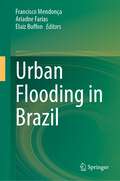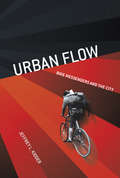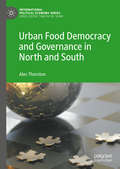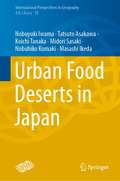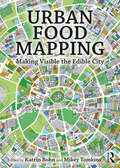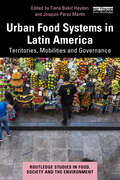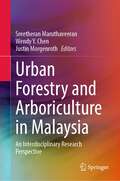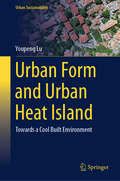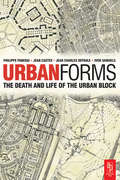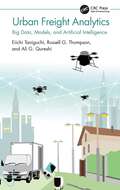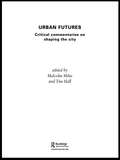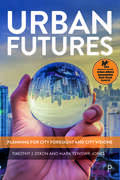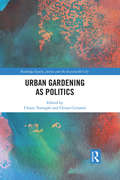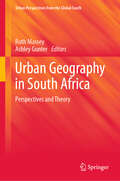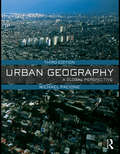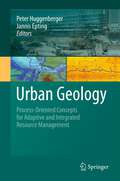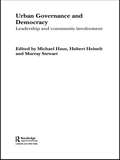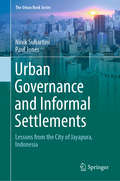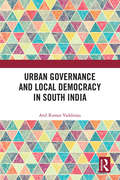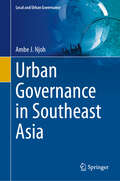- Table View
- List View
Urban Flooding in Brazil
by Francisco Mendonça Ariadne Farias Elaiz BuffonThis contributed volume analyzes flooding scenarios in Brazilian cities using a geographic and spatiotemporal approach to explore impacts and ways to mitigate future disasters. The problem of urban flooding is growing in Brazilian cities due to the increasing number of natural disasters in the context of global climate change; this is a topic that poses challenges to urban planners and academics. Through three sections, this volume offers theoretical-conceptual, methodological and technical case studies, as well as cases that explore urban socio-environmental problems associated with flooding. Throughout the book, the concepts of risk, vulnerability and adaptation are used to explore future flood scenarios in Brazil.The integrated vision offered in this volume covers the floods themselves, evaluation of flood impacts, and the management process before, during, and after the flood event. The case studies presented here elucidate the concept of comprehensive urban flood management, offering a technical and diagnostic basis for the problem in different cities in Brazil. The present and future challenges presented by these chapters offer widely-transferable lessons that can be applied to making cities around the world more sustainable and disaster-resilient.
Urban Flow: Bike Messengers and the City
by Jeffrey L. KidderBike messengers are familiar figures in the downtown cores of major cities. Tasked with delivering time-sensitive materials within, at most, a few hours—and sometimes in as little as fifteen minutes—these couriers ride in all types of weather, weave in and out of dense traffic, dodging (or sometimes failing to dodge) taxis and pedestrians alike in order to meet their clients' tight deadlines. Riding through midtown traffic at breakneck speeds is dangerous work, and most riders do it for very little pay and few benefits. As the courier industry has felt the pressures of first fax machines, then e-mails, and finally increased opportunities for electronic filing of legal "paperwork," many of those who remain in the business are devoted to their job. For these couriers, messengering is the foundation for an all-encompassing lifestyle, an essential part of their identity. In Urban Flow, Jeffrey L. Kidder (a sociologist who spent several years working as a bike messenger) introduces readers to this fascinating subculture, exploring its appeal as well as its uncertainties and dangers.Through interviews with and observation of messengers at work and play, Kidder shows how many become acclimated to the fast-paced, death-defying nature of the job, often continuing to ride with the same sense of purpose off the clock. In chaotic bike races called alleycats, messengers careen through the city in hopes of beating their peers to the finish line. Some messengers travel the world to take part in these events, and the top prizes are often little more than bragging rights. Taken together, the occupation and the messengers' after-hours pursuits highlight a creative subculture inextricably linked to the urban environment. The work of bike messengers is intense and physically difficult. It requires split-second reflexes, an intimate knowledge of street maps and traffic patterns, and a significant measure of courage in the face of both bodily harm and job insecurity. In Urban Flow, Kidder gives readers a rare opportunity to catch more than a fleeting glimpse of these habitués of city streets.
Urban Food Democracy and Governance in North and South (International Political Economy Series)
by Alec Thornton“Grounded in the urban politics of the 21st Century world-wide, this thoughtful volume hooks urban food – and especially its production – to social justice in a realistic and manageable way.” —Diana Lee-Smith, Mazingira Institute, Kenya“An excellent international overview of urban food democracy and governance, with impressive geographical reach.” —Andre Viljoen, University of Brighton, UKThis edited collection explores urban food democracy as part of a broader policy-based approach to sustainable urban development. Conceptually, governance and social justice provide the analytical framework for a varied array of contributions which critically address issues including urban agriculture, smart cities, human health and wellbeing and urban biodiversity. Some chapters take the form of thematic, issue-based discussions, where others are constituted by empirical case studies. Contributing authors include both academic experts and practitioners who hail from a wide range of disciplines, professions and nations. All offer original research and robust consideration of urban food democracy in cities from across the Global North and South. Taken as a whole, this book makes a significant contribution to understanding the potential enabling role of good urban governance in developing formal urban food policy that is economically and socially responsive and in tune with forms of community-driven adaptation of space for the local production, distribution and consumption of nutritious food.
Urban Food Deserts in Japan (International Perspectives in Geography #15)
by Koichi Tanaka Nobuyuki Iwama Tatsuto Asakawa Midori Sasaki Nobuhiko Komaki Masashi IkedaThis book introduces the Japanese urban food desert (FD). Currently, Japan has the most rapidly aging society in the world, with a shrinking population and food desert issues in connection with the isolation of the elderly people from their families and local communities. The types of food deserts that Japan is currently facing are likely to occur in many other countries under similar circumstances in the near future. This book serves as a valuable resource for researchers and policymakers who are working on FD issues in Japan as well as in other countries. The book consists of 8 chapters, with each chapter covering a different aspect of FD, and it also includes case studies, one of which is the FD in Tokyo.
Urban Food Mapping: Making Visible the Edible City
by Katrin Bohn Mikey TomkinsWith cities becoming so vast, so entangled and perhaps so critically unsustainable, there is an urgent need for clarity around the subject of how we feed ourselves as an urban species. Urban food mapping becomes the tool to investigate the spatial relationships, gaps, scales and systems that underlie and generate what, where and how we eat, highlighting current and potential ways to (re)connect with our diet, ourselves and our environments.Richly explored, using over 200 mapping images in 25 selected chapters, this book identifies urban food mapping as a distinct activity and area of research that enables a more nuanced way of understanding the multiple issues facing contemporary urbanism and the manyfold roles food spaces play within it. The authors of this multidisciplinary volume extend their approaches to place making, storytelling, in-depth observation and imagining liveable futures and engagement around food systems, thereby providing a comprehensive picture of our daily food flows and intrastructures. Their images and essays combine theoretical, methodological and practical analysis and applications to examine food through innovative map-making that empowers communities and inspires food planning authorities. This first book to systematise urban food mapping showcases and bridges disciplinary boundaries to make theoretical concepts as well as practical experiences and issues accessible and attractive to a wide audience, from the activist to the academic, the professional and the amateur. It will be of interest to those involved in the all-important work around food cultures, food security, urban agriculture, land rights, environmental planning and design who wish to create a more beautiful, equitable and sustainable urban environment.
Urban Food Systems in Latin America: Territories, Mobilities and Governance (Routledge Studies in Food, Society and the Environment)
by Tiana Bakić Hayden Joaquín Pérez MartínDrawing on a range of case studies from across Latin America, this book highlights the ways that urbanization shapes the food systems that feed this region’s cities, approaching the problem of food in cities as a particularly urban problem.Latin America is the most urbanized area in the world, with nearly 80% of the population living in cities, where rates of food and nutritional insecurity are persistently high, and where the social and spatial organization is characterized by inequality and segregation. The broader questions addressed in this volume are as follows: How do the specific processes and dynamics of Latin American urbanization influence or shape food systems? How can urban food systems develop forms of governance that supports food security and sustainability? After a general introduction, this volume is organized into three main sections: Territories, mobilities, and governance. The chapters consider how specific elements such as urban planning, zoning, migration, gentrification, informal settlements, logistics, retailers, wholesale markets and street vendors, among others, contribute to shaping how food is distributed, sold, and bought in cities. Drawing on studies and theoretical approaches written by scholars and practitioners from Argentina, Brazil, Chile, Ecuador and Mexico, this book provides a Latin American perspective on global discussions surrounding the role of cities in ensuring food access to urban populations.This volume will be of great interest to students, scholars, and policymakers interested in food systems, urban food, urban planning, sustainable urban development, and Latin American studies.
Urban Forestry and Arboriculture in Malaysia: An Interdisciplinary Research Perspective
by Sreetheran Maruthaveeran Wendy Y. Chen Justin MorgenrothThis book represents the latest research on urban forestry in a Malaysian context. It demonstrates that urban forestry is concerned not only with environmental enhancement, but also other aspects, such as recreation, health and well-being, and government policies. This edited collection provides a comprehensive overview of urban forestry studies from various researchers in Malaysia, and includes rich historical perspectives of urban forestry in the country. It also tackles related issues in policy. The greening of urban Malaysia in the 1970s focused primarily on beautification and was primarily the province of horticulturists, landscapers, nursery workers, town planners, and architects, with negligible inputs from foresters, particularly urban foresters. Perhaps for that reason, the term “landscaping” has been used more widely than “urban forestry” by government and private institutions, politicians, stakeholders, academicians, and the public. Nevertheless, the authors show that the concept of urban forestry is not new for developing countries such as Malaysia, where urbanization is increasing at a rapid rate. The book unpacks this demographic shift from a predominantly rural to a principally urban society. As the only unified body of work on urban forestry and arboricultural studies in Malaysia, this volume presents an important interdisciplinary reference for students, researchers, and scholars in physical geography, forestry and urban forestry, arboriculture and landscape architecture, both in Malaysia, and in other developing urbanizing countries, particularly in Southeast Asia. It is also an important resource for those working in environmental policy and practice, excavating the vital connection between the environment and well-being.
Urban Form and Urban Heat Island: Towards a Cool Built Environment (Urban Sustainability)
by Youpeng LuThis book provides a comprehensive exploration of the spatial patterns, drivers, mechanisms and management strategies associated with urban heat islands (UHI). It presents new insights into how urban form shapes the thermal environment of cities, shedding light on previously unexplored aspects of UHI dynamics and urban cooling strategies. The key features of this book include: 1. Comprehensive coverage of the influence of urban form on UHI intensity, from spatial patterns to regulatory strategies. 2. Practical implications and recommendations for urban planning and policy formulation to mitigate UHI effects and enhance urban sustainability. Written for researchers, urban planners, policymakers and environmental practitioners, this book provides valuable insights into understanding and addressing the challenges posed by UHI in rapidly urbanising environments. It is suitable for advanced graduate level courses in urban studies, environmental science and geography.
Urban Forms: Death And Life Of The Urban Block
by Ivor Samuels Phillippe Panerai Jean Castex Jean Charles DepauleThis popular and influential work, translated here into English for the first time, argues that modern urbanism has upset the morphology of cities, abolished their streets and isolated their buildings. In tracing the stages of this transformation, this book presents the view that the urban tissue, the intermediate scale between the architecture of buildings and the diagrammatic layouts of town planning, is the essential framework for everyday life. Only by investigating the urban tissue will it be possible to understand the complex relationships between plot and built form, between streets and buildings and between these forms and design practices.The chosen trail of the first French edition - Paris, London, Amsterdam, Frankfurt - is one of continuously evolving modernity. It outlines a history, which, in one century (1860-1960), completely changed the aspect of our towns and cities and transformed our way of life. The shock has been such that we are still looking for answers, still attempting to find urban forms that can accommodate present day ways of life and at the same time maintain the qualities of the traditional town.This English edition brings the story forward to the present day and considers the impact of the New Urbanism in the United States, which, over the last decade, has sought to re-establish former relationships within the urban tissue.
Urban Freight Analytics: Big Data, Models, and Artificial Intelligence
by Eiichi Taniguchi Russell G. Thompson Ali G. QureshiUrban Freight Analytics examines the key concepts associated with the development and application of decision support tools for evaluating and implementing city logistics solutions. New analytical methods are required for effectively planning and operating emerging technologies including the Internet of Things (IoT), Information and Communication Technologies (ICT), and Intelligent Transport Systems (ITS). The book provides a comprehensive study of modelling and evaluation approaches to urban freight transport. It includes case studies from Japan, the US, Europe, and Australia that illustrate the experiences of cities that have already implemented city logistics, including analytical methods that address the complex issues associated with adopting advanced technologies such as autonomous vehicles and drones in urban freight transport. Also considered are future directions in urban freight analytics, including hyperconnected city logistics based on the Physical Internet (PI), digital twins, gamification, and emerging technologies such as connected and autonomous vehicles in urban areas. An integrated modelling platform is described that considers multiple stakeholders or agents, including emerging organisations such as PI companies and entities such as crowd-shippers as well as traditional stakeholders such as shippers, receivers, carriers, administrators, and residents. This book Presents procedures for evaluating city logistics technologies and policy measures Provides an overview of advanced modelling approaches, including agent-based model and machine learning Highlights the essential features of optimisation and simulation models applied to city logistics Discusses how models incorporating more uncertainty and dynamic data can be used to improve the sustainability and resilience of urban freight systems The book is ideal for graduate students in civil and environmental engineering and logistics management, urban planners, transport engineers, and logistics specialists.
Urban Future 21: A Global Agenda for Twenty-First Century Cities
by Peter Hall Ulrich PfeifferPrepared for the World Commission on Twenty-First Century Urbanization Conference in Berlin in July 2000. This book is an entirely new and comprehensive review of the state of world urban development at the millennium and a forecast of the main issues that will dominate urban debates in the next 25 years. It is the most significant book on cities and city planning problems to appear for many years.
Urban Futures: Critical Commentaries on Shaping Cities
by Malcolm Miles Tim HallUrban Futures brings together commentaries from a wide range of contemporary disciplines and fields relevant to urban culture, form and society. The book concerns cities in the broadest sense, not just as buildings and spaces, but also as processes and events or sites of occupation, in which meanings are constructed in many ways. The contributors draw on their specialist areas of research to inform current debate, but they also speculate as to how cities will be shaped in the 21st century.Specific areas of research include homeless people's organisations and restoration ecology in brownfield sites in the USA, post-industrial urban landscapes, post-industrial economics, tourism and cultural planning. The book allows each writer to state their own conclusions, but together they suggest that tomorrow's cities will, while remaining locations of difference and contestation, be rapidly evolving systems in which dwellers assume increasing responsibilities and power.
Urban Futures: Planning for City Foresight and City Visions
by Mark Tewdwr-Jones Timothy J. DixonCity visions represent shared, and often desirable, expectations about our urban futures. This book explores the history and evolution of city visions, placing them in the wider context of art, culture, science, foresight and urban theory. It highlights and critically reviews examples of city visions from around the world, contrasting their development and outlining the key benefits and challenges in planning such visions. The authors show how important it is to think about the future of cities in objective and strategic ways, engaging with a range of stakeholders – something more important than ever as we look to visions of a sustainable future beyond the COVID-19 crisis.
Urban Gardening as Politics (Routledge Equity, Justice and the Sustainable City series)
by Chiara Certomà Chiara TornaghiWhile most of the existing literature on community gardens and urban agriculture share a tendency towards either an advocacy view or a rather dismissive approach on the grounds of the co-optation of food growing, self-help and voluntarism to the neoliberal agenda, this collection investigates and reflects on the complex and sometimes contradictory nature of these initiatives. It questions to what extent they address social inequality and injustice and interrogates them as forms of political agency that contest, transform and re-signify ‘the urban’. Claims for land access, the right to food, the social benefits of city greening/community conviviality, and insurgent forms of planning, are multiplying within policy, advocacy and academic literature; and are becoming increasingly manifested through the practice of urban gardening. These claims are symptomatic of the way issues of social reproduction intersect with the environment, as well as the fact that urban planning and the production of space remains a crucial point of an ever-evolving debate on equity and justice in the city. Amid a mushrooming over positive literature, this book explores the initiatives of urban gardening critically rather than apologetically. The contributors acknowledge that these initiatives are happening within neoliberal environments, which promote –among other things - urban competition, the dismantling of the welfare state, the erasure of public space and ongoing austerity. These initiatives, thus, can either be manifestation of new forms of solidarity, political agency and citizenship or new tools for enclosure, inequality and exclusion. In designing this book, the progressive stance of these initiatives has therefore been taken as a research question, rather than as an assumption. The result is a collection of chapters that explore potentials and limitations of political gardening as a practice to envision and implement a more sustainable and just city.
Urban Geography in Postcolonial Zimbabwe: Paradigms and Perspectives for Sustainable Urban Planning and Governance (The Urban Book Series)
by Innocent Chirisa Abraham R. Matamanda Verna NelThis interdisciplinary book provides a cross-sectoral and multi-dimensional exploration and assessment of the urban geography perspectives in Zimbabwe. Drawing on work from different disciplines, the book not only contributes to academia but also seeks to inform urban policy with the view of contributing to the national aspirations of Zimbabwe attaining middle-income status by 2030. Adopting a multi-dimensional assessment that transcends disciplines such as urban and regional planning, human and physical geography, urban governance, political science, economics and development studies, the book provides a background for co-production concerning urban development in the Global South.The book contributes into its analysis of the institutional and legislative framework that relates to the urban geography of Zimbabwe, as these are responsible for the evolution of the urban system in the country. The connections among different sectors and issues such as environment, economy, politics and the wider objectives of the SDGs, especially goal 11 aspiring to create sustainable communities by 2030, are explored. The success stories relating to urban geography in Zimbabwe are identified together with the best possible practices that may inform urban planning, policy and management.
Urban Geography in South Africa: Perspectives and Theory (GeoJournal Library)
by Ruth Massey Ashley GunterThis book embraces South Africa and its place in the Global South, providing a succinct theoretical and empirical analysis and discussion of urban issues in the country. There have been sporadic calls from the Urban Geography community for the development of an overarching and comprehensive text that explores contemporary processes and practices taking place in urban South Africa and, more widely, the Global South. This is an edited collection of chapters by leading urban theorists and practitioners working on various themes within urban South Africa and serves as a base for scholars and students interested in urban perspectives from countries in the Global South.
Urban Geography: A Global Perspective
by Michael PacioneToday, for the first time in the history of Humankind urban dwellers outnumber rural residents. Urban places, towns and cities, are of fundamental importance – for the distribution of population within countries; in the organization of economic production, distribution and exchange; in the structuring of social reproduction and cultural life; and in the allocation and exercise of power. Furthermore, in the course of the present century the number of urban dwellers and level of global urbanisation are destined to increase. Even those living beyond the administrative or functional boundaries of a town or city will have their lifestyle influenced to some degree by a nearby, or even distant, city. The analysis of towns and cities is a central element of all social sciences including geography, which offers a particular perspective on and insight into the urban condition. The principal goal of this third edition of the book remains that of providing instructors and students of the contemporary city with a comprehensive introduction to the expanding field of urban studies. The structure of the first two editions is maintained, with minor amendments. Each of the thirty chapters has been revised to incorporate recent developments in the field. All of the popular study aids are retained; the glossary has been expanded; and chapter references and notes updated to reflect the latest research. This third edition also provides new and expanded discussions of key themes and debates including detailed consideration of metacities, boomburgs, public space, urban sprawl, balanced communities, urban economic restructuring, poverty and financial exclusion, the right to the city, urban policy, reverse migration , and traffic and transport problems. The book is divided into six main parts. Part one outlines the field of urban geography and explains the importance of a global perspective. Part two explores the growth of cities from the earliest times to the present day and examines the urban geography of the major world regions. Part three considers the dynamics of urban structure and land use change in Western cities. Part four focuses on economy, society and politics in the Western city. In part five attention turns to the urban geography of the Third World, where many of the countries experiencing highest rates or urban growth are least well equipped to respond to the economic, social, political and environmental challenge. Finally part six affords a prospective on the future of cities and cities of the future. New to this edition are: further readings based on the latest research; updated data and statistics; an expanded glossary; new key concepts; additional study questions; and a listing of useful websites. The book provides a comprehensive interpretation of the urban geography of the contemporary world. Written in a clear and readable style, lavishly illustrated with more than eighty photographs, 180 figures, 100 tables and over 200 boxed studies and with a plethora of study aids Urban Geography: A Global Perspective represents the ultimate resource for students of urban geography.
Urban Geology
by Peter Huggenberger Jannis EptingUrban subsurface resources and particularly urban groundwater are vulnerable to environmental impacts, and their rational management is of major importance. In this book a multidisciplinary team of specialists and scientists presents innovative process-oriented approaches to the sustainable use of these resources. The included case studies from northwestern Switzerland describe representative environments and are relevant for urban areas in general. They illustrate the protection of groundwater; river restoration; engineering and hydrogeological questions related to urban infrastructure and management concepts; as well as monitoring, modeling and remediation strategies for contaminated sites; problems caused by karst in urban environments; the use of shallow geothermal energy; and natural hazards such as flood events and earthquakes. It is demonstrated that modern quantitative earth sciences can contribute significantly in finding solutions concerning the sustainable use of subsurface resources in urban environments. The book is an invaluable source of information for hydrogeologists, geologists, urban planners, water supply engineers, and environmental agencies.
Urban Governance Voice and Poverty in the Developing World
by Nick DevasPoverty and governance are both issues high on the agenda of international agencies and governments in the South. With urban areas accounting for a steadily growing share of the world's poor people, an international team of researchers focused their attention on the hitherto little-studied relationship between urban governance and urban poverty. In their timely and in-depth examination of ten cities in Africa, Asia and Latin America, they demonstrate that in many countries the global trends towards decentralization and democratization offer new opportunities for the poor to have an influence on the decisions that affect them. They also show how that influence depends on the nature of those democratic arrangements and decision-making processes at the local level, as well as on the ability of the poor to organize. The study involved interviews with key actors within and outside city governments, discussions with poverty groups, community organizations and non-governmental organizations (NGOs), as well as analyses of data on poverty, services and finance. This book presents insights, conclusions and practical examples that are of relevance for other cities. It outlines policy implications for national and local governments, NGOs and donor agencies, and highlights ways in which poor people can use their voice to influence the various institutions of city governance.
Urban Governance and Democracy: Leadership and Community Involvement (Routledge Studies in Governance and Public Policy #Vol. 8)
by Michael Haus Hubert Heinelt Murray StewartThe issue of local governance is high on the institutional agenda of many local and regional authorities throughout the OECD countries. This book explores the relationship between two key issues of urban governance - leadership and community involvement - and how making these two elements more complementary can lead to more effective as well as legitimate policy outcomes.The authors examine the dilemmas involved in ensuring effective governance, focusing on issues such as legitimacy, citizen participation, economic performance and social inclusion.
Urban Governance and Informal Settlements: Lessons from the City of Jayapura, Indonesia (The Urban Book Series)
by Paul Jones Ninik SuhartiniThe objective of this book is to better understand the nature of urban governance regarding the provision of basic urban services in rapidly growing mid-sized towns and cities in developing countries. Set within the context of understanding urban planning and management within the wider city setting, the study focuses on the provision of the basic urban services of housing, water and sanitation especially within informal settlements. Using the case study of the mid-sized city of Jayapura, Papua, Indonesia, the publication explores: (i) the types, processes, and stakeholders that constitute formal urban governance in the provision of basic urban services; (ii) understanding how stakeholders gain and benefit from ‘on the ground’ formal service arrangements, and why; and (iii) for those who do not directly benefit from the formal arrangements, how individuals, groups and communities organize and access governance to meet their basic urban needs. The methods employed to better understand the nature of urban governance and its relationship to the provision of basic urban services comprised primary (face-to-face household surveys interviewing 448 respondents, ground mapping at a plot size level in four informal settlements, and semi-structured interviews with 12 stakeholders) and secondary data regarding urban governance, planning and management. The study reveals that urban governance arrangements in fast growing mid-sized cities have emerged both formally and informally to cope with basic urban service needs across a range of settlement types and socio-cultural groups. The major modes of governance arrangements in the informal settlements consist of traditional, formal and informal, and hybrid governance which co-evolve as their boundaries overlap and intersect through time at varying levels of ‘equilibrium’. The ‘governance equilibrium’ represents a ‘balance’ at a specific point and place in time in how stakeholders utilize and share resources, and access various contributions.
Urban Governance and Local Democracy in South India
by Anil Kumar VaddirajuThis book examines the issues of urban governance and local democracy in South India. It is the first comprehensive volume that offers comparative frameworks on urban governance across all states in the region: Karnataka, Andhra Pradesh, Telangana, Tamil Nadu and Kerala. The book focuses on governance in small district-level cities and raises crucial questions such as the nature of urban planning, major outstanding issues for urban local governance, conditions of civic amenities such as drinking water and sanitation and problems of social capital in making urban governance work in these states. It emphasizes on both efficient urban governance and effective local democracy to meet the challenges of fast-paced urbanization in these states while presenting policy lessons from their urbanization processes. Rich in empirical data, this book will be useful to scholars and researchers of political studies, public administration, governance, public policy, development studies and urban studies, as well as practitioners and non-governmental organizations.
Urban Governance in Southeast Asia (Local and Urban Governance)
by Ambe J. NjohThe book draws from regulation theory to explain urban planning policies and outcomes in Southeast Asia as a function of governance structures and processes. A considerable portion of the book is spent re-tracing the historical roots of planning dispositives, including the totality of institutional entities, which together constitute an apparatus of government in South-East Asian polities. Therefore, of essence in the book are the institutional structures and administrative principles, that were introduced by colonial authorities and inherited by their post-colonial successors in South-East Asia. The book seeks to demonstrate the role of the policies and commensurate implementation institutional frameworks in accounting for important dynamics in the contemporary urban domain in the region. In analyzing the institutional framework for urban planning and governance, the book is doing due diligence to a hitherto neglected subject, namely governmentality, in the discourse on the political economy of urban management in Southeast Asia. Thus, the book is intended to acknowledge the importance of institutions in determining the success of urban development policies. The notion of institutions or governmentality as will be used in the book includes, de facto governance structures, government and parastatal agencies and the formal rules and regulations they are charged with implementing. The book is based on the premise that knowledge of institutions and their functions is critical in explaining phenomena in economic geography. This is particularly true in Southeast Asian countries because of the dominant and overarching role of the state or government agencies in the economy.
Urban Governance in Southern Europe (Urban And Regional Planning And Development Ser.)
by Abel AlbetThe concept of governance has evolved into one of the most important but also controversial concepts in urban politics. While it encourages co-operation, participation and collective construction, at the same time, it has brought about new forms of public demission, oligarchic regimes and less local democracy. The dilemmas accompanying these changes are particularly relevant when observing the cities of Southern Europe, whose socio-cultural specificities very much structure local political and policy materialisations. Bringing together a team of leading scholars from across the social sciences, this volume examines the issues of urban governance in the Southern European context. Illustrated by case studies of several main cities and metropoles on the North Mediterranean coast, it introduces and critically analyses the latest theories and approaches to urban governance. It questions how the 'real' or socio-cultural notion of city seems to have been separated from that of the 'political' city and explores how more integrated socio-political forms might be developed. It looks at current structures, dynamics and cultures of governance in urban development and questions whether they are well adapted to new realities and challenges or whether there are significant imbalances causing limited or fragmented political-administrative visions. By considering both the long Mediterranean history along with the recent but enduring global economic and political developments, this book argues that Southern European cities will have to depend greatly upon its own socio-cultural networks, dynamics and cosmopolitan evolution, making the most of the region's characteristic urban strengths, as trading hubs, with rich hinterlands and large and varied population.
Urban Governance in Transition (Understanding China)
by Hongshan YangThis book offers readers a comprehensive introduction to the functions of the government in contemporary China. Further, it creates a framework to describe urban governance in today’s China, which consists of four basic modes: the omnipotent government mode, autonomous governance mode, integrated governance mode and cooperative governance mode. The book defines a “city” as a gathering place for high-quality public service resources, and the basic task of urban governance is to provide high-quality public services and maintain the sustainability of fiscal revenues. By focusing on current “hot topics” in urban governance in China, including the institutional development of urban governance, model interpretation, city/county relationship, cross-border governance, cross-sectoral coordination, street management, community service provision, and municipal performance evaluation, it clarifies a number of common misunderstandings in the field of urban management and practice. Lastly, the book analyses the current integrated governance model used in Chinese cities, which relies on the authority of the government and integrates the market and social subjects across borders by means of qualification identification, resource support, elite absorption, party-group embeddedness, and project cooperation. However, this model is currently facing several problems. In order to address the potential risks of integrated governance, the book argues that we need to develop new institutional arrangements based on collaborative governance.
